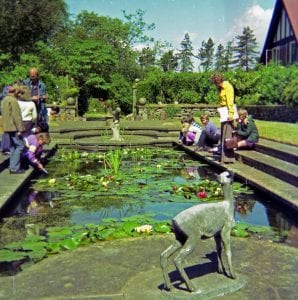The University of Bristol Botanic Garden was established in 1882. Since opening, we have moved location three times.
University Road and Tyndall Avenue
In 1882 Bristol University College awarded Adolf Leipner (Lecturer of Botany) a grant of £15 to build a botanic garden. Leipner raised an extra £89 and the garden was built.
The original site was waste ground next to the newly opened buildings of University College at the top of University Road, near Royal Fort House in Clifton.
Later the garden moved to a site by Tyndall Avenue, and became known as Hiatt Baker Garden. The garden remained there until 1959 when Senate House was built on that site.
Bracken Hill

With the building of Senate House in 1959, the garden and collections were moved to Bracken Hill.
Built in 1886, Bracken Hill had been the home of Melville Wills, a noted benefactor of the University.
For 46 years until 2005, the Botanic Garden remained at Bracken Hill.
In 2002 the University reviewed its estates and gardens policy. We decided to relocate the botanical collections to establish a new Botanic Garden closer to the University campus.
The Holmes

The Holmes at Stoke Bishop was the chosen site, and this is where you can find the garden today.
Situated opposite Churchill Hall, The Holmes was built in 1879 in the 'Arts and Crafts' style as a large residential house within 1.77 hectares of gardens.
During the planning of the Normandy landings in 1944, The Holmes was used as a base for top US Army generals and today the house functions as a university hall of residence and small conference centre.
The relatively undeveloped ornamental garden at The Holmes was an ideal location for the new garden. It was a similar size to Bracken Hill and within walking distance of the University and city centre.
The move gave us the opportunity to design the new garden in a new way, different from traditional botanic gardens. Ours was the first university botanic garden to be created in the United Kingdom in nearly forty years.
Top garden designers Land Use Consultants, whose previous commissions include The Eden Project and Heligan, drew up a design for the garden. They worked in close consultation with the Garden Director, Professor Simon Hiscock, the Curator, Nicholas Wray, External Estates Manager Alan Stealey and a team of botanical and horticultural advisors.
The Curatorial Advisory Group agreed the final design in July 2004. It offers a meandering 'organic' trail through a blend of informal and formal plantings. We designed the garden to be both educational and attractive.
Professor Sir Peter Crane, Director of The Royal Botanic Gardens, Kew, specialist botanical advisor on the project said:
"It has been wonderful to follow the process of developing the new Botanic Garden. This is an important investment by the University that will not only enhance teaching and research, but that will also further enrich the City of Bristol for all its citizens".

